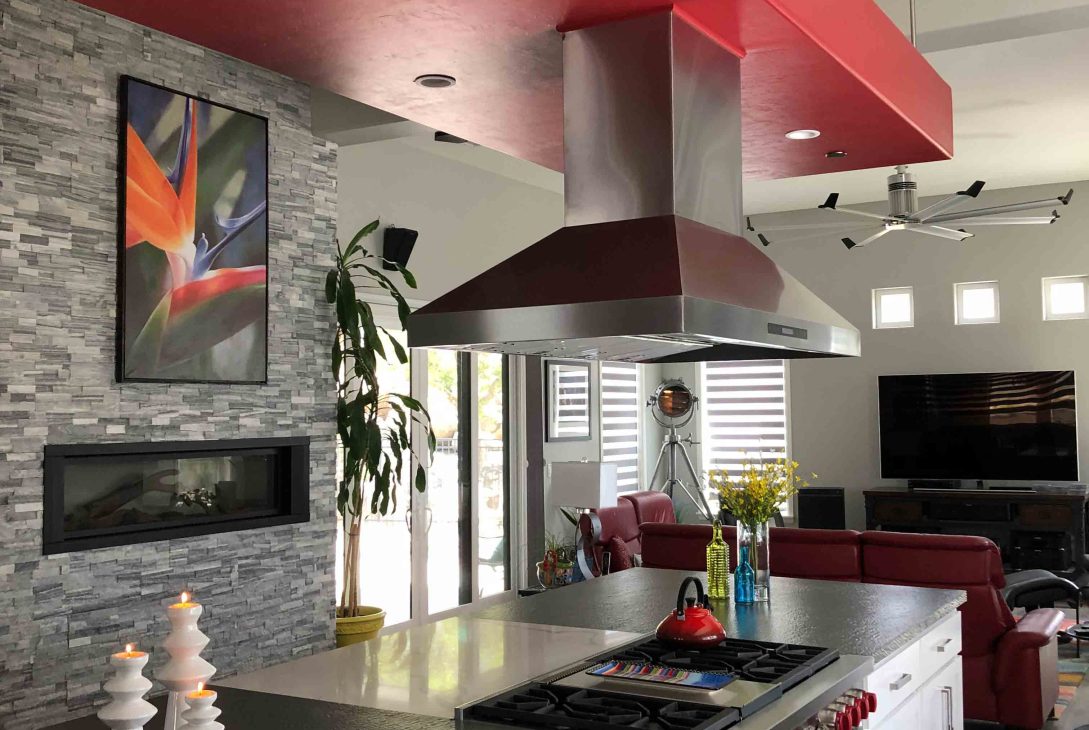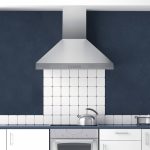To install a range hood without a cabinet, first, determine the right location and gather necessary tools. Next, mark the spots where it will be installed and properly connect the wiring and ductwork for ventilation.
Range hoods are essential in every kitchen, as they help in removing airborne grease, smoke, and other harmful pollutants. Many homeowners prefer a range hood over the stove and forego cabinets to increase ventilation in the kitchen. If your home lacks kitchen cabinets and you want to install a range hood, there’s no need to worry.
Installing a range hood without a cabinet isn’t as challenging as it may seem. In this article, we’ll guide you through the necessary steps for a successful range hood installation without a cabinet, including the tools you’ll need and the factors to consider before getting started. With our help, you’ll have a functional range hood in no time.

Credit: www.webstaurantstore.com
Tools You May Need:
- Plywood
- Table Saw
- Kreg Jig
- Kreg Screws
- Self-Tapping screws
- 2.5 or 3-inch Wood screws
- Drill
- Finish Nailer and Nails
- Wood Glue
- Wood Screws
- Stud Finder
Benefits Of Installing A Range Hood Without Cabinets
More Flexibility In Placement And Design
When it comes to installing a range hood without cabinets, one of the biggest benefits is the added flexibility in placement and design options. With cabinets, the range hood must be installed within the structure of the cabinetry, limiting your placement possibilities.
However, without a cabinet, you have the freedom to position the range hood wherever you please. Not only that, but the removal of cabinets opens up the space and can create a more open and customizable kitchen design.
- You are not limited to cabinet structure or placement.
- You can install the range hood wherever you like.
- You can create a more open and customizable kitchen design.
Cost Savings Compared To Cabinet Installation
Another benefit of installing a range hood without cabinets is the cost savings compared to cabinet installation. Cabinets can be quite expensive, and if you’re renovating an entire kitchen, those costs can quickly add up. By removing the cabinets, you can bypass this cost entirely and allocate those funds towards other aspects of your kitchen renovation.
- You can save money on expensive cabinets.
- Those funds can be reallocated for other parts of your kitchen renovation.
- You can avoid the costs associated with cabinet installation.
Easy Installation Process With No Need For Cabinet Modifications
Installing a range hood without cabinets is a straightforward process that doesn’t require any modifications to existing cabinetry. With cabinet installation, modifications to the cabinetry are necessary to properly install the range hood, which can be both time-consuming and expensive.
Without cabinets, the installation process is simplified, and most range hoods come with installation instructions that are easy to follow.
- Installation process is quick and easy.
- No modifications to existing cabinetry are necessary.
- Most range hoods come with easy-to-follow installation instructions.
Materials Needed For Hassle-Free Range Hood Installation
Range Hood Unit Compatible With Non-Cabinet Installation
Installing a range hood without a cabinet can be a tricky task, but not when you have the right range hood unit. Choose one that’s compatible with non-cabinet installation, and you’re halfway there. Here are the key points to keep in mind:
- Look for a range hood that comes with a wall bracket. This bracket will help secure the range hood to the wall without requiring a cabinet.
- Ensure that the range hood is lightweight and has a slim design. A bulky range hood will require more support, which is challenging to achieve without a cabinet.
Ductwork And Wall Cap
The next essential aspect of a hassle-free range hood installation is ductwork and a wall cap. The ductwork expels all the smoke and grease from the kitchen out of your home, while the wall cap prevents rainwater and animals from entering your home through the range hood duct.
- Make sure the duct diameter is compatible with the range hood you’ve chosen.
- Properly secure the duct to the range hood using a duct connector.
- Ensure that the wall cap is flush with the wall and sealed with silicone caulking to prevent any leakage.
Ventilation Fan
Adding a ventilation fan can help improve the airflow and ventilation of your range hood. Here’s what you need to consider:
- Ensure that the ventilation fan is compatible with your range hood unit and ductwork.
- Choose a fan that’s quiet, energy-efficient, and easy to clean.
- Properly secure the ventilation fan to the wall or ceiling, depending on your installation preference.
Soffit Panels Or Trim Work, Depending On Design Preference
Adding soffit panels or trim work is an excellent way to make your range hood installation look great. Here are the key points to keep in mind:
- Choose a design that complements your kitchen’s style and your personal preferences.
- Ensure that the soffit panels or trim work aligns with your range hood unit’s dimensions.
- Properly secure the soffit panels or trim work to the wall, making sure that it’s level and flush.
Installing a range hood without a cabinet can seem challenging, but it’s entirely doable with the proper materials and knowledge. Keep the above points in mind, and you’ll have a hassle-free, functional, and beautiful range hood installation in no time.
Steps For Installing A Range Hood Without Cabinets
Prepare The Designated Area For The Range Hood Installation.
Before installing a range hood, you need to prepare the area by following these steps:
- Remove any cabinets or shelves that may obstruct the installation area.
- Ensure that the installation site is in line with the ductwork and ventilation fan to allow proper ventilation.
- Check for electrical outlets nearby to power the vent hood.
- Secure the wall where you will fix the range hood.
Install The Necessary Ductwork And Ventilation Fan.
Installing ductwork and ventilation fan is an important process of a range hood installation. Follow these steps:
- Measure and cut a hole in the wall for the air to escape.
- Install the ventilation fan and connect it to the ductwork.
- Or, you may use the pre-existing ducts already in place, which is less complicated.
- Make sure the vent ducts are made of 25-gauge galvanized sheet metal to prevent damage over time.
Affix The Range Hood Unit To The Wall.
For fixing the range hood unit to the wall, you can follow these steps:
- Position the range hood to the location and make sure it is leveled.
- Drill the screws in the mounting bracket to affix the range hood to the wall.
- Tighten the screws to mount the range hood to the wall.
- Once secured, turn the range hood on to test it.
Install Soffit Panels Or Trim Work Around The Range Hood.
Soffit panels or trim work around the hood can smoothen the area and complete the installation. Follow these steps:
- Measure and cut the soffit panels to match the installation area.
- Use nail gun to attach the soffit panels in place.
- Make sure the panels are secure by adding additional screws if needed.
Test The Range Hood To Ensure Proper Function.
Before finishing the installation, it’s important to test the range hood for effective operation. Here are the steps:
- Turn on the range hood and check to see if there’s enough suction.
- Move smoke or steam over the range hood and ensure that they are sucked up into the ductwork and ventilation fan.
- Make sure the light is on and functioning correctly.
By following these steps, you can easily learn how to install a range hood without cabinets. It is always best to consult the manufacturer’s installation instructions manual for guidance. Now you can enjoy a clean and fresh kitchen free from fumes and airborne particles with your new range hood!
Additional Tips For Hassle-Free Range Hood Installation
Determine The Appropriate Size Of The Range Hood For Your Kitchen.
Before installing a range hood without a cabinet, it’s important to determine the appropriate size of the unit for your kitchen. Here are some tips to help you with the process:
- Measure the width of your cooktop or range and ensure that the range hood is at least as wide as the cooktop.
- To calculate the required range hood airflow, measure the kitchen area’s size in cubic feet. A good rule of thumb is to multiply the kitchen’s cubic footage by 15 to get the required cfm (cubic feet per minute) rating.
- Choose the right mounting height. The bottom of the range hood should be a minimum of 24-30 inches above the cooktop.
Choose A Range Hood Unit That Complements Your Kitchen’S Design.
Choosing the right range hood unit that complements your kitchen’s design can make a big difference. Here are some things to consider when choosing a range hood unit:
- Determine the style of your kitchen. If your kitchen has a more traditional look, a decorative range hood will work well. If your kitchen has a modern look, a sleek, stainless steel unit will fit right in.
- Consider the space available. If you have limited space, consider choosing a compact range hood unit that is suitable for small kitchens.
- Check the noise level. You don’t want a range hood unit that is too noisy. Look for units with a low sone rating for quieter operation.
Hire A Professional If You Are Unsure About The Installation Process Or Need Electrical Work.
Installing a range hood without a cabinet can be challenging, especially if you are unsure about the installation process or need electrical work. Here’s why you might consider hiring a professional:
- Professionals have the experience and knowledge to install your range hood unit quickly and efficiently.
- They know the appropriate wiring and electrical work to be done to ensure the range hood operates optimally.
- Hiring a professional ensures that your safety is taken care of. Poor installation can lead to electrical shocks, fires, and other hazards.
Frequently Asked Questions For How To Install Range Hood Without Cabinet
Can I Install A Range Hood Without A Cabinet?
Yes, you can install a range hood without a cabinet. You can use an under-cabinet range hood with a protective cover for this purpose. It is also possible to install a ductless range hood that doesn’t require a vent pipe to the outside.
What Are The Steps To Install A Range Hood Without A Cabinet?
First, turn off the power supply. Then, determine the height for the hood and mark it on the wall. Install the mounting brackets and secure them to the wall studs. Install the range hood and connect the electric wires and vent pipe.
Finally, turn on the power and test the hood.
How High Should A Range Hood Be Installed Above The Cooktop?
A range hood should be installed at a height that allows it to effectively capture cooking smoke and grease. The ideal distance above the cooktop surface is 24 to 30 inches. For gas cooktops, it should be at least 30 inches while for electric cooktops, it should be at least 24 inches.
Should A Range Hood Be Vented Outside?
Yes, it is best to vent a range hood outside to expel smoke, moisture, and cooking odors outside instead of recirculating them back into the room. A vented hood eliminates unhealthy pollutants and helps to maintain a comfortable indoor environment.
What Are The Benefits Of Installing A Range Hood?
Installing a range hood helps to remove smoke, heat, moisture and various cooking odors that can accumulate in the kitchen. It also helps to improve indoor air quality and prevent harmful pollutants from circulating in the home. In addition, it helps to prevent grease buildup on walls and cabinets, reducing the risk of a fire.
Conclusion
Finally, installing a range hood without a cabinet is achievable by going through the instructions provided by the manufacturer. You need accurate measurements, the right tools, and an organized workspace to ensure a smooth installation process. Consider the ductwork to ensure proper ventilation, and choose the perfect location for your range hood.
Make sure all electrical requirements are met, and test the range hood before using it. With these steps, you can successfully install your range hood without a cabinet at a lower cost. Follow these guidelines correctly to achieve your desired results and improve air quality in your kitchen.
Remember, safety is paramount, so always seek professional help whenever you need it. Taking the time to install your range hood properly will make it a valuable addition to your kitchen and ultimately improve your cooking experience.

Freda is a passionate foodie and kitchen gadget enthusiast. With over 10 years of experience in the culinary industry, Freda brings her expertise in testing and reviewing kitchen gadgets.





